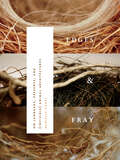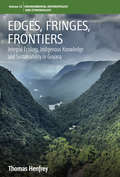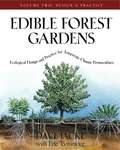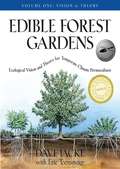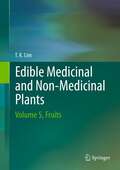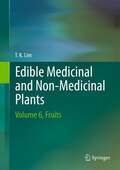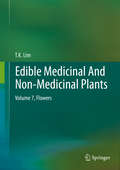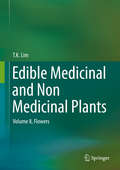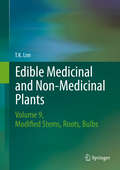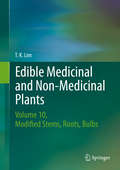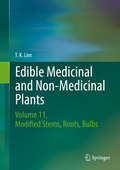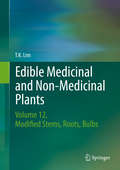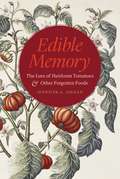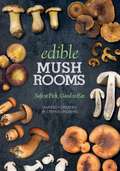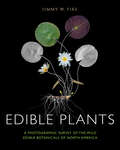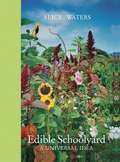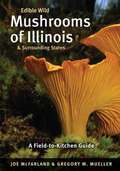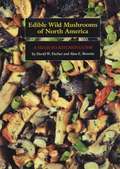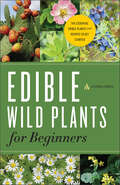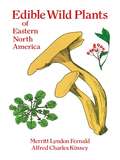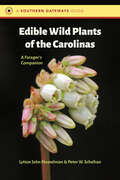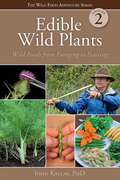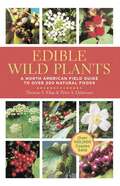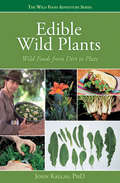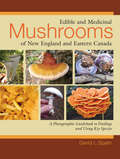- Table View
- List View
Edges & Fray: on language, presence, and (invisible) animal architectures (Wesleyan Poetry Ser.)
by Danielle VogelPoetry, prose, and photographs, explore the edges of languageEdges & Fray is an embodied meditation that cultivates receptivity and deep listening to the ways we inhabit language and its ethereal resilience. Combining close observation of birds' nests and the writing process, Danielle Vogel brings the reader into communion with language as a mode of presence. The frayed edges of consciousness are carefully arranged to suggest how writing, and the book, can serve as a site of radical transformation. Experimental and deeply grounded, this work is lyrical and patient. The text creates overlapping ecological fields, wherein each field is a system always in a state of becoming. Finding its strength in fragility, Edges & Fray is personal without feeling private, experimental without feeling programmatic. Its construction is intuitive and masterful, its many threads interwoven and intrinsically linked. This is a beautiful and inspiring book at the intersection of poetry, somatics, ecology, and divination.
Edges, Fringes, Frontiers: Integral Ecology, Indigenous Knowledge and Sustainability in Guyana (Environmental Anthropology and Ethnobiology #23)
by Thomas HenfreyBased on an ethnographic account of subsistence use of Amazonian forests by Wapishana people in Guyana, Edges, Frontiers, Fringes examines the social, cultural and behavioral bases for sustainability and resilience in indigenous resource use. Developing an original framework for holistic analysis, it demonstrates that flexible interplay among multiple modes of environmental understanding and decision-making allows the Wapishana to navigate social-ecological complexity successfully in ways that reconcile short-term material needs with long-term maintenance and enhancement of the resource base.
Edible Forest Gardens: Ecological Design And Practice For Temperate Climate Permaculture (Volume #2)
by Eric Toensmeier Dave JackeIn Volume II, Dave Jacke and Eric Toensmeier move on to practical considerations: concrete ways to design, establish, and maintain your own forest garden. Along the way they present case studies and examples, as well as tables, illustrations, and a uniquely valuable "plant matrix" that lists hundreds of the best edible and useful species.
Edible Forest Gardens: Ecological Vision And Theory For Temperate Climate Permaculture Volume 1
by Eric Toensmeier Dave JackeEdible Forest Gardens is a groundbreaking two-volume work that spells out and explores the key concepts of forest ecology and applies them to the needs of natural gardeners in temperate climates. Volume I lays out the vision of the forest garden and explains the basic ecological principles that make it work.
Edible Medicinal And Non-Medicinal Plants: Volume 5, Fruits
by T. K. LimThis book continues as volume 5 of a multicompendium on Edible Medicinal and Non-Medicinal Plants. It covers edible fruits/seeds used fresh, cooked or processed as vegetables, cereals, spices, stimulant, edible oils and beverages. It covers selected species from the following families: Apiaceae, Brassicaceae, Chenopodiaceae, Cunoniaceae, Lythraceae, Papaveraceae, Poaceae, Polygalaceae, Polygonaceae, Proteaceae, Ranunculaceae, Rhamnaceae, Rubiaceae, Salicaceae, Santalaceae, Xanthorrhoeaceae and Zingiberaceae. This work will be of significant interest to scientists, medical practitioners, pharmacologists, ethnobotanists, horticulturists, food nutritionists, botanists, agriculturists, conservationists, lecturers, students and the general public. Topics covered include: taxonomy; common/English and vernacular names; origin and distribution; agroecology; edible plant parts and uses; botany; nutritive/pharmacological properties, medicinal uses, nonedible uses; and selected references.
Edible Medicinal And Non-Medicinal Plants: Volume 6, Fruits
by T. K. LimThis book continues as volume 6 of a multi-compendium on Edible Medicinal and Non-Medicinal Plants. It covers edible fruits/seeds used fresh, cooked or processed into other by-products, or as vegetables, cereals, spices, stimulant, edible oils and beverages. It covers selected species from the following families: Sapindaceae, Sapotaceae, Schisandraceae, Solanaceae, Thymelaeaceae, Urticaceae, Vitaceae and Winteraceae. This work will be of significant interest to scientists, researchers, medical practitioners, pharmacologists, ethnobotanists, horticulturists, food nutritionists, agriculturists, botanists, conservationists, lecturers, students and the general public. Topics covered include: taxonomy; common/English and vernacular names; origin and distribution; agroecology; edible plant parts and uses; botany; nutritive and pharmacological properties, medicinal uses and research findings; nonedible uses; and selected references.
Edible Medicinal And Non-Medicinal Plants: Volume 7, Flowers
by T. K. LimThis book continues as volume 7 of a multi-compendium on Edible Medicinal and Non-Medicinal Plants. It covers plant species with edible flowers from families Acanthaceae to Facaceae in a tabular form and seventy five selected species from Amaryllidaceae, Apocynaceae, Asclepiadaceae, Asparagaceae, Asteraceae, Balsaminaceae, Begoniaceae, Bignoniaceae, Brassicaceae, Cactaceae, Calophyllaceae, Caprifoliaceae, Caryophyllaceae, Combretaceae, Convolvulaceae, Costaceae, Doryanthaceae and Fabaceae in detail. This work will be of significant interest to scientists, medical practitioners, pharmacologists, ethnobotanists, horticulturists, food nutritionists, botanists, agriculturists, conservationists, lecturers, students and the general public. Topics covered include: taxonomy; common/English and vernacular names; origin and distribution; agroecology; edible plant parts and uses; botany; nutritive/pharmacological properties, medicinal uses, nonedible uses; and selected references.
Edible Medicinal and Non Medicinal Plants: Volume 8, Flowers
by T. K. LimVolume 8 is part of a multicompendium Edible Medicinal and Non-Medicinal Plants, on plants with edible flowers from Geraniaceae to Zingiberaceae (tabular) and 82 species in Geraniaceae, Iridaceae, Lamiaceae, Liliaceae, Limnocharitaceae, Magnoliaceae, Malvaceae, Meliaceae, Myrtaceae, Nyctaginaceae, Nymphaeaceae, Oleaceae, Onagraceae, Orchidaceae, Paeoniaceae, Papaveraceae, Plantaginaceae, Poaceae, Polygonaceae, Primulaceae, Proteaceae, Ranunculaceae, Rosaceae, Rubiaceae, Rutaceae, Solanaceae, Theaceae, Tropaeolaceae, Tyhpaceae, Violaceae, Xanthorrhoeaceae and Zingiberaceae in detail. This work is of significant interest to medical practitioners, pharmacologists, ethnobotanists, horticulturists, food nutritionists, botanists, agriculturists, conservationists and general public. Topics covered include: taxonomy; common/ vernacular names; origin/ distribution; agroecology; edible plant parts/uses; botany; nutritive/medicinal properties, nonedible uses and selected references.
Edible Medicinal and Non Medicinal Plants: Volume 9, Modified Stems, Roots, Bulbs
by T. K. LimVolume 9 is part of a multicompendium Edible Medicinal and Non-Medicinal Plants, on plants with edible modified stems, roots and bulbs from Acanthaceae to Zygophyllaceae (tabular) and 32 selected species in Alismataceae, Amaryllidaceae, Apiaceae, Araceae, Araliaceae, Asparagaceae, Asteraceae, Basellaceae, Brassicaceae and Campanulaceae in detail. This work is of significant interest to medical practitioners, pharmacologists, ethnobotanists, horticulturists, food nutritionists, botanists, agriculturists, conservationists, and general public. Topics covered include: taxonomy; common/ vernacular names; origin/ distribution; agroecology; edible plant parts/uses; botany; nutritive/medicinal properties, nonedible uses and selected references.
Edible Medicinal and Non-Medicinal Plants: Volume 10, Modified Stems, Roots, Bulbs
by T. K. LimVolume 10 is part of a multi compendium Edible Medicinal and Non-Medicinal Plants. This work is of significant interest to medical practitioners, pharmacologists, ethnobotanists, horticulturists, food nutritionists, botanists, agriculturists, conservationists and general public. 59 plant species with edible modified stems, roots and bulbs in the families Amaranthaceae, Cannaceae, Cibotiaceae, Convolvulaceae, Cyperaceae, Dioscoreaceae, Euphorbiaceae, Fabaceae, Iridaceae, Lamiaceae, Marantaceae, Nelumbonaceae, Nyctaginaceae, Nymphaeaceae, Orchidaceae, Oxalidaceae, Piperaceae, Poaceae, Rubiaceae, Simaroubaceae, Solanaceae, Tropaeolaceae, Typhaceae and Zingiberaceae. Topics covered include: taxonomy; common/ vernacular names; origin/ distribution; agroecology; edible plant parts/uses; botany; nutritive/medicinal properties, nonedible uses and selected references.
Edible Medicinal and Non-Medicinal Plants: Volume 11 Modified Stems, Roots, Bulbs
by T. K. LimThis book covers such plants with edible modified storage subterranean stems (corms, rhizomes, stem tubers) and unmodified subterranean stem stolons, above ground swollen stems and hypocotyls, storage roots (tap root, lateral roots, root tubers), and bulbs, that are eaten as conventional or functional food as vegetables and spices, as herbal teas, and may provide a source of food additive or neutraceuticals. This volume covers selected plant species with edible modified stems, roots and bulbs in the families Iridaceae, Lamiaceae, Marantaceae, Nelumbonaceae, Nyctaginaceae, Nymphaeaceae, Orchidaceae, Oxalidaceae, Piperaceae, Poaceae, Rubiaceae and Simaroubaceae. The edible species dealt with in this work include wild and underutilized crops and also common and widely grown ornamentals.To help in identification of the plant and edible parts coloured illustrations are included.<P><P> As in the preceding ten volumes, topics covered include: taxonomy (botanical name and synonyms); common English and vernacular names; origin and distribution; agro-ecological requirements; edible plant parts and uses; plant botany; nutritive, medicinal and pharmacological properties with up-to-date research findings; traditional medicinal uses; other non-edible uses; and selected/cited references for further reading. This volume has separate indices for scientific and common names; and separate scientific and medical glossaries.
Edible Medicinal and Non-Medicinal Plants: Volume 12 Modified Stems, Roots, Bulbs
by T. K. LimThis book covers such plants with edible modified storage subterranean stems (corms, rhizomes, stem tubers) and unmodified subterranean stem stolons, above ground swollen stems and hypocotyls, storage roots (tap root, lateral roots, root tubers), and bulbs, that are eaten as conventional or functional food as vegetables and spices, as herbal teas, and may provide a source of food additive or neutraceuticals. This volume covers selected plant species with edible modified stems, roots and bulbs in the families Iridaceae, Lamiaceae, Marantaceae, Nelumbonaceae, Nyctaginaceae, Nymphaeaceae, Orchidaceae, Oxalidaceae, Piperaceae, Poaceae, Rubiaceae and Simaroubaceae. The edible species dealt with in this work include wild and underutilized crops and also common and widely grown ornamentals. To help in identification of the plant and edible parts coloured illustrations are included.<P><P> As in the preceding ten volumes, topics covered include: taxonomy (botanical name and synonyms); common English and vernacular names; origin and distribution; agro-ecological requirements, edible plant parts and uses; plant botany; nutritive, medicinal and pharmacological properties with up-to-date research findings; traditional medicinal uses; other non-edible uses; and selected/cited references for further reading. This volume has separate indices for scientific and common names; and separate scientific and medical glossaries.
Edible Memory: The Lure of Heirloom Tomatoes and Other Forgotten Foods
by Jennifer A. JordanEach week during the growing season, farmers markets offer up such delicious treasures as brandywine tomatoes, cosmic purple carrots, pink pearl apples, and chioggia beets varieties of fruits and vegetables that are prized by home chefs and carefully stewarded by farmers from year to year. These are the heirlooms and the antiques of the food world, endowed with their own rich histories. While cooking techniques and flavor fads have changed from generation to generation, a Ribston Pippin apple today can taste just as flavorful as it did in the eighteenth century. But how does an apple become an antique and a tomato an heirloom? In "Edible Memory," Jennifer A. Jordan examines the ways that people around the world have sought to identify and preserve old-fashioned varieties of produce. In doing so, Jordan shows that these fruits and vegetables offer a powerful emotional and physical connection to a shared genetic, cultural, and culinary past. Jordan begins with the heirloom tomato, inquiring into its botanical origins in South America and its culinary beginnings in Aztec cooking to show how the homely and homegrown tomato has since grown to be an object of wealth and taste, as well as a popular symbol of the farm-to-table and heritage foods movements. She shows how a shift in the 1940s away from open pollination resulted in a narrow range of hybrid tomato crops. But memory and the pursuit of flavor led to intense seed-saving efforts increasing in the 1970s, as local produce and seeds began to be recognized as living windows to the past. In the chapters that follow, Jordan combines lush description and thorough research as she investigates the long history of antique apples; changing tastes in turnips and related foods like kale and parsnips; the movement of vegetables and fruits around the globe in the wake of Columbus; and the poignant, perishable world of stone fruits and tropical fruit, in order to reveal the connections the edible memories these heirlooms offer for farmers, gardeners, chefs, diners, and home cooks. This deep culinary connection to the past influences not only the foods we grow and consume, but the ways we shape and imagine our farms, gardens, and local landscapes. From the farmers market to the seed bank to the neighborhood bistro, these foods offer essential keys not only to our past but also to the future of agriculture, the environment, and taste. By cultivating these edible memories, Jordan reveals, we can stay connected to a delicious heritage of historic flavors, and to the pleasures and possibilities for generations of feasts to come. "
Edible Mushrooms: Safe to Pick, Good to Eat
by Stefan Lindberg Barbro ForsbergWandering the woods in search of mushrooms is one of life's great pleasures. But be careful to pick the right ones! With Edible Mushrooms in your backpack, you'll know to pick only the safest, most delicious chanterelles, truffles, morels, and more. Author Barbro Forsberg presents forty edible species, and reveals how, when, and where to find them-knowledge gained over the course of four decades spent mushrooming in the woods.Discover such aspects of mushrooming as: Characteristics of edible mushrooms, per species Cooking, cleaning, and drying the day's bounty Edible, inedible, or toxic? Photographs and descriptions for what to pick and what to avoid Poisonous varieties and how to recognize themAll content has been verified by a professional mycologist. Plus, nature and educational photographs illustrate how mushrooms grow, the environments where you can expect to find them, and the ways in which the same species may vary from one sample to the next. So whether you're an experienced mushroom hunter or a novice to the art, with Edible Mushrooms you can confidently recognize, pick, and eat the tastiest wild mushrooms.
Edible Plants: A Photographic Survey of the Wild Edible Botanicals of North America
by Jimmy FikeFor over a decade, artist Jimmy Fike traveled across the continental United States in an epic effort to photograph wild edible flora. Edible Plants is the culmination of that journey, featuring over 100 photographs that Fike has selectively colorized to highlight the comestible part of the plant. While the images initially appear to be scientific illustrations or photograms from the dawn of photography when plants were placed directly on sensitized paper and exposed under the sun, a closer look reveals, according to Liesl Bradner of the Los Angeles Times, "haunting [and] eerily beautiful" photographs. Beyond instilling wonder, Fike's contemporary, place-based approach to landscape photography emphasizes our relationship to the natural world, reveals food sources, and encourages environmental stewardship. His clever and beautiful method makes it easy to identify both the specimen and its edible parts and includes detailed descriptions about the plant's wider purposes as food and medicine.Sumptuously illustrated and delightfully informative, Edible Plants is the perfect gift for anyone curious about unlocking the secrets of native North American plants.
Edible Schoolyard: A Universal Idea
by Alice Waters David Liittschwager Daniel DuaneOne of America's most influential chefs, Alice Waters created a revolution in 1971 when she introduced local, organic fare at her Berkeley, California, restaurant, Chez Panisse. Twenty-five years later, she and a small group of teachers and volunteers turned over long-abandoned soil at an urban middle school in Berkeley and planted the Edible Schoolyard. The schoolyard has since grown into a universal idea of Edible Education that integrates academics with growing, cooking, and sharing wholesome, delicious food. With inspiring images of the garden and kitchen and their young caretakers. Edible Schoolyard is at once a visionary model for sustainable farming and childhood nutrition, and a call to action for schools across the country.
Edible Wild Mushrooms of Illinois and Surrounding States: A Field-to-Kitchen Guide
by Joe Mcfarland Gregory M. MuellerLavishly illustrated with nearly three hundred gorgeous full-color photos, this engaging guidebook carefully describes forty different edible species of wild mushrooms found around Illinois and surrounding states, including Iowa, Wisconsin, Missouri, Indiana, and Kentucky. With conversational and witty prose, the book provides extensive detail on each edible species, including photographs of potential look-alikes to help you safely identify and avoid poisonous species. Mushroom lovers from Chicago to Cairo will find their favorite local varieties, including morels, chanterelles, boletes, puffballs, and many others. Veteran mushroom hunters Joe McFarland and Gregory M. Mueller also impart their wisdom about the best times and places to find these hidden gems. Edible Wild Mushrooms of Illinois and Surrounding States also offers practical advice on preparing, storing, drying, and cooking with wild mushrooms, presenting more than two dozen tantalizing mushroom recipes from some of the best restaurants and chefs in Illinois, including one of Food & Wine magazine's top 10 new chefs of 2007. Recipes include classics like Beer Battered Morels, Parasol Mushroom Frittatas, and even the highly improbable (yet delectable) Morel Tiramisu for dessert. As the first new book about Illinois mushrooms in more than eighty years, this is the guide that mushroom hunters and cooks have been craving. Visit the book's companion website at www.illinoismushrooms.com.
Edible Wild Mushrooms of North America
by Alan E. Bessette David W. FischerUnusual shapes and colors make many mushrooms alluring to the eye, while the exotic flavors and textures of edible mushrooms are a gourmet delicacy for the palate. Yet many people never venture beyond the supermarket offerings, fearing that all other mushrooms are poisonous.With amateur mushroom hunters especially in mind, David Fischer and Alan Bessette have prepared Edible Wild Mushrooms of North America. This field guide presents more than 100 species of the most delicious mushrooms, along with detailed information on how to find, gather, store, and prepare them for the table. More than 70 savory recipes, ranging from soups and salads to casseroles, canapes, quiches, and even a dessert, are included.Throughout, the authors constantly emphasize the need for correct identification of species for safe eating. Each species is described in detailed, nontechnical language, accompanied by a list of key identifying characteristics that reliably rule out all but the target species. Superb color photographs also aid in identification. Poisonous "lookalikes" are described and illustrated, and the authors also assess the risks of allergic or idiosyncratic reactions to edible species and the possibilities of chemical or bacterial contamination.
Edible Wild Plants for Beginners: The Essential Edible Plants and Recipes to Get Started
by Althea PressDig up a whole new culinary world with this New York Times best-selling field guide to foragingMost of us "forage" for food in the aisles of well-lit grocery stores. But there are delicious edible plants for the taking right outside your door! This all-in-one reference shows you how to identify 31 of the most common edible wild plants in North America, from California to Connecticut.Gather your gear—Dive into edible plant history and foraging FAQs, and learn what tools you'll need before you head out.Spot the snacks—Find photos, descriptions, distinguishing characteristics, and common uses for 31 edible wild plants—from arrowroot to wild rose.Recipes and remedies—Learn to use wild plants in everything from curry and cookies to bug bite balm and bath soaks.Stay safe—This book includes foraging guidelines that are vital to your safety. It's recommended you read it in its entirety before you explore.Make the most of what Mother Nature has to offer with Edible Wild Plants for Beginners.
Edible Wild Plants of Eastern North America
by Merritt Lyndon Fernald Alfred Charles KinseyEveryone knows that certain mushrooms and species of berries are edible, but how many have experienced a salad of cat-brier sprouts, bread made of acorn-flour or seeds of cow lilies, escalloped roots of goat's-beard, sautéed ground-nuts, marmalade of squaw-huckleberry, pudding made of dried persimmons and other natural delights?This book offers a complete guide to such non-packaged, free-for-the-picking natural foods, arranged according to uses: purees and soups; cooked green vegetables; salads; pickles; drinks; syrups and sugars, confections; fresh or preserved fruits, jellies, and marmalades; starchy or root-vegetables, cereals, nuts, and breadstuffs; nibbles and relishes; condiments and seasoning; rennets; table-oils and butters; masticatories and chewing gums; and emergency foods.The heart of the volume is a detailed enumeration of 1,000 species of edible wild plants and ferns of eastern North America, including the plant's common and scientific names, appearance, range, habitat, food uses, and other data. The plants are arranged systematically by families, following the sequence now generally accepted by botanists. A wealth of detailed drawings and photographs will help in identifying plants in the field.Also included here is a helpful chapter on poisonous flowering plants likely to be mistaken for edible species, and a valuable treatment of mushrooms, seaweeds, and lichens. For any naturalist, hiker, camper, or lover of wild foods, this is an authoritative, information-packed guide that is indispensable for using the wealth of delicious, healthful foods available all around us.
Edible Wild Plants of the Carolinas: A Forager’s Companion (Southern Gateways Guides)
by Lytton John Musselman Peter W. SchafranForaging edible plants was once limited to specialists, survivalists, and herbalists, but it's become increasingly mainstream. Influenced by the popularity of the locavore movement, many restaurants feature foraged plants on their menus, and a wide variety of local foraged plants are sold at farmers markets across the country. With Edible Wild Plants of the Carolinas, Lytton John Musselman and Peter W. Schafran offer a full-color guide for the everyday forager, featuring: - Profiles of more than 100 edible plants, organized broadly by food type, including seeds, fruits, grains, and shoots- Details about taste and texture, harvesting tips, and preparation instructions- Full-color photos that make it easy to identify edible plantsEdible Wild Plants of the Carolinas is designed to help anyone enjoy the many wild plants found in the biodiverse Carolinas.
Edible Wild Plants, Volume 2: Wild Foods from Foraging to Feasting (Wild Food Adventure)
by John KallasThis second volume of Edible Wild Plants adds 18 additional plants, their relatives, and look-a-likes, in 15 plant chapters, to the overall collection of plants covered between the two volumes in The Wild Food Adventure Series. This book makes it delightfully exciting to learn about and experiment with known wild foods that will be useful to all, from beginners to advanced foragers. This book features plants in five flavor categories―foundation, tart, pungent or peppery, bitter, and distinctive & sweet. Organizing this way helps readers use the plants in pleasing and predictable ways. Imagine frequently including cattail, nettles, pokeweed, marsh mallow, daylily, wild radish, and everlasting pea in your meal planning knowing that you acquired these plants from your own foraging adventures. There is also a section devoted to identifying and knowing poison hemlock, often confused with wild carrot in certain stages of development. John Kallas and his Wild Food Adventure book series are here to help you learn quickly, process intelligently, and genuinely enjoy what you are eating.
Edible Wild Plants: A North American Field Guide to Over 200 Natural Foods
by Thomas Elias Peter DykemanPlanning an outdoor adventure? Make sure to consult this information-packed and photo-filled North American field guide—arranged by season and region—before you go! <p><p> Already a huge success in previous editions, this must-have field guide now features a fresh new cover, as well as nearly 400 color photos and detailed information on more than 200 species of edible plants all across North America. <p><p> With all the plants conveniently organized by season, enthusiasts will find it very simple to locate and identify their desired ingredients. Each entry includes images, plus facts on the plant’s habitat, physical properties, harvesting, preparation, and poisonous look-alikes. The introduction contains tempting recipes and there’s a quick-reference seasonal key for each plant.
Edible Wild Plants: Wild Foods From Dirt To Plate (The\wild Food Adventure Ser.)
by John KallasThe founder of Wild Food Adventures presents the definitive, fully illustrated guide to foraging and preparing wild edible greens.Beyond the confines of our well-tended vegetable gardens, there is a wide variety of fresh foods growing in our yards, neighborhoods, or local woods. All that&’s needed to take advantage of this wild bounty is a little knowledge and a sense of adventure. In Edible Wild Plants, wild foods expert John Kallas covers easy-to-identify plants commonly found across North America. The extensive information on each plant includes a full pictorial guide, recipes, and more.This volume covers four types of wild greens:Foundation Greens: wild spinach, chickweed, mallow, and purslaneTart Greens: curlydock, sheep sorrel, and wood sorrelPungent Greens: wild mustard, wintercress, garlic mustard, and shepherd&’s purseBitter Greens: dandelion, cat&’s ear, sow thistle, and nipplewort
Edible and Medicinal Mushrooms of New England and Eastern Canada: A Photographic Guidebook to Finding and Using Key Species
by David L. SpahrThis beautifully illustrated guidebook provides specific, easy-to-understand information on finding, collecting, identifying, and preparing the safer and more common edible and medicinal mushroom species of New England and Eastern Canada. Author David Spahr, a trained commercial photographer, here combines his mycological expertise and photographic skill to produce an attractive and detailed overview of his subject. Based on decades of practical experience and research, the book is written in a clear and forthright style that avoids the dry, generic descriptions of most field guides. Edible and Medicinal Mushrooms of New England and Eastern Canada also provides useful ideas for cooking mushrooms. Rather than simply providing recipes, the book discusses the cooking characteristics of each variety, with advice about matching species with appropriate foods. Many mushrooms contain unique medicinal components for boosting the immune system to fight cancer, HIV, and other diseases, and Spahr offers practical and prudent guidelines for exploration of this rapidly emerging area of alternative therapeutic practice.
